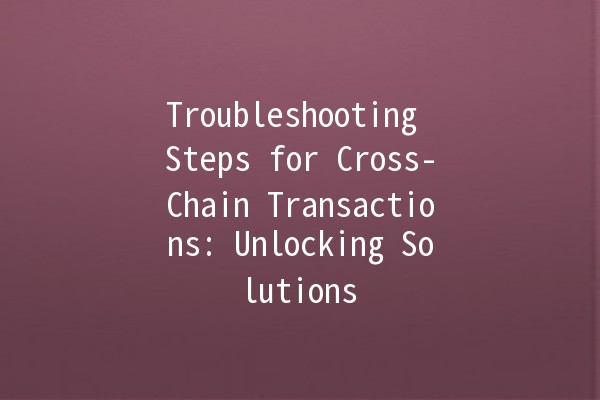
Crosschain transactions have revolutionized the way digital assets are transferred and utilized across different blockchain networks. However, despite their benefits, users often encounter challenges that can impede their transactions. This article explores the troubleshooting steps for crosschain transactions, offering practical tips and insights to enhance your experience.
Understanding CrossChain Transactions
Before diving into troubleshooting, it's essential to understand what crosschain transactions entail. Crosschain technology allows for the interoperability of different blockchains, enabling users to transfer assets from one chain to another without relying on centralized exchanges. This innovation enhances liquidity and provides access to various decentralized applications (dApps) across blockchain ecosystems.
Crosschain transactions can be complex, often involving multiple protocols and smart contracts. Some common issues arise from network incompatibilities, smart contract failures, or user error. Below are practical strategies to troubleshoot and resolve these issues effectively.

Explanation:
Before initiating a crosschain transaction, ensure both chains involved are compatible and operational. Some blockchains may not support certain token types or standards, which can lead to transaction failures.
Application Example:
For instance, if you are transferring ERC20 tokens from Ethereum to Binance Smart Chain (BSC), confirm that your token is compatible with BSC. You can check the blockchain’s official documentation or use trusted crosschain bridges like AnySwap or ThorChain that list supported tokens.
Explanation:
Network congestion or outages can significantly impact the success of your transaction. Always check the current status of the involved blockchains to avoid transaction failure due to downtime.
Application Example:
Utilize platforms such as Blockchair or CoinMarketCap that provide realtime blockchain statistics. If one of the blockchains is experiencing issues, you may need to wait until it's resolved before proceeding.
Explanation:
Many crosschain transactions require users to approve smart contracts before allowing them to execute transfers. Failing to properly approve contracts can lead to unsuccessful transactions.
Application Example:
If you're using a decentralized exchange (DEX) for a crosschain swap, ensure that you have granted permission to the DEX's smart contract to spend your tokens. This can typically be done through the "Approve" function in your wallet interface. Check your wallet's activity log to confirm whether the approval transaction was completed successfully.
Explanation:
High transaction fees can result in failures, especially if the sender does not have sufficient funds to cover the costs. Always check the required fees before initiating a transaction.
Application Example:
For Ethereum transactions, use platforms like EthGasStation to estimate current gas prices. If gas prices are significantly high, consider performing your transaction during offpeak hours or on an alternative chain that may have lower fees.
Explanation:
Choosing a reliable and wellregarded crosschain protocol can minimize the chances of encountering issues. Research and select protocols known for their security and efficiency.
Application Example:
Protocols such as Polkadot and Cosmos facilitate crosschain interactions through their respective architectures. When opting for a crosschain solution, consider utilizing bridges or swaps that have undergone thorough audits and have positive community feedback to reduce risks associated with transaction failures.
Common Issues and Their Solutions
Problem: Transactions may get stuck due to network congestion or low fees.
Solution: Monitor the transaction on a blockchain explorer. If it’s stuck, consider speeding it up with a higher gas fee.
Problem: Sending tokens to an unsupported address may result in loss.
Solution: Always doublecheck the wallet address and ensure it belongs to the correct blockchain.
Problem: Some wallets may not support crosschain functions.
Solution: Use wallets known for crosschain capabilities, such as MetaMask or Trust Wallet, to ensure compatibility.
Problem: Smart contracts may fail due to coding errors or incorrect parameters.
Solution: Review the smart contract code for issues. If you're not familiar with smart contracts, seek assistance from experienced developers or forums.
Problem: Transactions may take longer than expected to confirm.
Solution: Patience is crucial, but if delays persist, check the network’s health and the status of your transaction on a blockchain explorer.
Problem: Users may receive incorrect amounts posttransaction.
Solution: Verify the transaction details closely and consult the DEX or wallet support for discrepancies.
and Next Steps
Navigating crosschain transactions can sometimes pose unique challenges. By employing these troubleshooting steps, you will be better equipped to handle potential issues that arise in the process. Always remain vigilant and update your knowledge regarding new developments within the blockchain space to enhance your transaction experience.
Further Engagement
For more indepth articles and insights about crosschain technologies and their applications, explore additional resources on our website or subscribe for updates. Help us build a robust community by sharing your experiences or questions about crosschain transactions!
This article aims to provide clarity on troubleshooting crosschain transactions effectively while integrating practical tips for you to enhance your blockchain experience. The information shared is designed to empower users with knowledge and tools to navigate their crosschain journey successfully.

